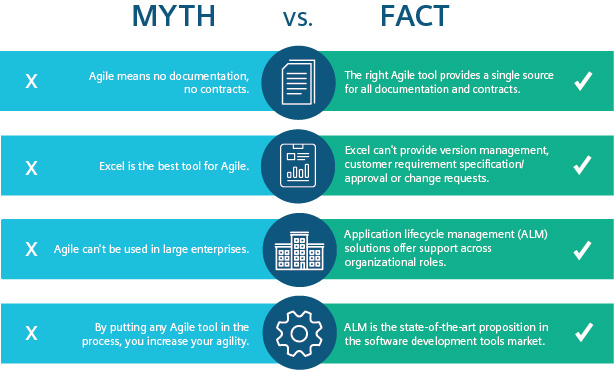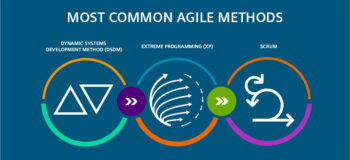Myths and misconceptions about Agile software development

While traditional waterfall software development principles are generally considered the least risky, Agile methods have proven their ability to improve project success rates. Even though Agile has gained mainstream popularity, there are still some common myths and misunderstandings around what Agile is and isn’t.
Myth #1 – Agile means no documentation and no contracts
One misconception organizations have when implementing agile concepts is that developers don’t have to document anything, and stakeholders can provide fuzzy or unclear descriptions of needs. These two sides often play a game of “they didn’t say it was required” or “we didn’t know,” leading to disappointment and missed targets. The right Agile tool provides a single source for all documentation, contracts, and requirements. The information is readily available across teams and organizations and keeps a record of changes so that everyone’s on the same page.
Myth #2 – Excel is the best tool for Agile software development
Organizations often say they are Agile, and the tool they rely on isn’t tracking what they think it is. Excel alone can’t provide version management, customer requirement specification/approval, test management, change requests, customer support, and more. The right Agile tool offers a means to manage requirements, versions, change requests, testing, and more.
Myth #3 – Large enterprises can’t use Agile software development
Application lifecycle management (ALM) solutions offer broad support to people in many roles often found at larger organizations. An incremental approach with the right tool will lead to successful enterprise Agile adoption.
Myth #4 – By putting any Agile tool in the process, you increase your agility
The right tool makes the difference—it needs to cover multiple disciplines, measure process quality, and support process improvements. Without a genuine foundation that involves the process flow, launching a successful agile program can be difficult. ALM is the state-of-the-art proposition in the software development tools market that embeds process knowledge and drives users through the process. This infographic shares some of the important factors in evaluating Agile and ALM.
One of the biggest challenges is determining if an organization is ready to scale Agile and hybrid models to an enterprise level. Evaluating enterprise readiness, understanding Agile software development, and determining organizational goals are essential for launching a successful Agile program.
Learn more about challenges transitioning to enterprise agile and Scaled Agile Framework (SAFe®) in this short video.



